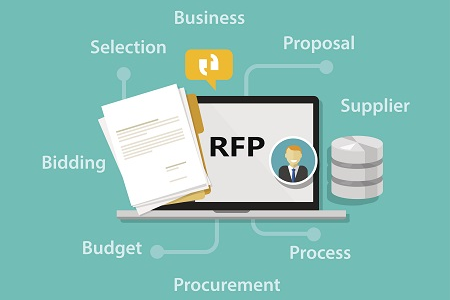Login
Login
Register
Complete Your Profile
Change Password
Request a Password Reset
Download Documents
Download Documents
Get Help to Participate in This Tender
Change Password
For better security, update the account password.
Home > RFP: Secrets of Writing a Winning Request for Proposal

We often hear the term RFP when dealing with projects, tenders, and third-party agreements. Most of us do not understand what is RFP and how to write one. This article will help you to understand the specific details of what is an RFP, the nuances of writing a good RFP, the RFP process and how to respond to an RFP.
Understanding RFP Definition and its Contents

RFP or request for proposal is a document released by business organizations, government organizations or not-for-profit agencies to call for proposals for new projects or for outsourcing existing operations. This document contains details about the project and intimates interested parties to revert with their proposals to take up the project. RFPs are published in national newspapers, trade journals, websites and can be distributed to potential bidders.
The major reason for publishing RFPs is to attract multiple bids for the project. The organization publishing the RFP can get bids from multiple parties interested to take up the project. Each bid presents a unique perspective of handling the project as the bidders will include their action plan to handle the requirements.
For instance, if a business organization is planning to automate its business operations and wants to finalize IT services companies for the job, it can float an RFP inviting companies interested to apply for the project. Once the organization receives bids from different companies interested in IT project management, it can go through each bid and know the action plan of different companies. It can then finalize an IT service company that has a comprehensive action plan and quotes the most competitive rates.
A Request for Proposal generally consists of the following information
Introduction to the company publishing the RFP
Scope of the project
Nature of the project
Contract terms
Bidding process
How to format and present the bids
Information required to be provided in the bids
Evaluation criteria to finalize the contract
Timeline to provide the finished work
Payment details
Incentives and penalties
Last date of submitting the bids
Contact information
The Purpose of Writing a Request for Proposal RFP

There are three major reasons to start the RFP process.
Finding a Suitable Vendor - Publishing an RFP in trade journals and national newspapers helps business organizations to find suitable vendors to handle the project.
Improve Accountability and Transparency - Publishing an RFP helps an organization to solicit bids from familiar as well as unknown companies. The organization can then compare the bids and select the most competitive bid with a suitable plan of action to handle the project. This process encourages transparency and eliminates corruption.
Government Regulations- In some cases, government regulations need certain companies to float RFPs and attract bids.
Understanding the RFP Process

The steps in the RFP process can vary from one organization to another. However, these are some of the common steps in the RFP Process.
Identify the Stakeholders- Writing RFP is a time-consuming process, which requires a detailed understanding of your organization, nature of the project and unique requirements of the project. It is essential to identify the stakeholders that can guide the RFP writer in identifying the project requirements and constraints, receiving and evaluating the bids and finalizing them.
Understand the Project Requirements and Boundaries- The first step in writing an RFP is to understand the project requirements and major constraints. Speak to all the stakeholders and know about the budget of the project, non-negotiable deadlines, and compulsory technical requirements.
Determine the Scoring Criteria- You have to determine the scoring criterion to evaluate the prospective bidders. You can take advise from the stakeholders of the project and other advisors to draft the scoring criterion. The scoring criteria mostly depend on the priorities of the organization in selecting the bidders. For example, You can select prior experience, location, price quote, size of the company as the scoring criteria.
Writing the RFP- The next step involves writing the request for proposal. The RFP document should contain information about the organization, short description of the project, project objectives, budget, milestones, and deadlines to achieve them, information required in the bid and deadline for submission of the bid. You can either create the RFP from scratch or use the RFP templates available online if you are not confident about how to write an RFP.
Publishing the RFP- Once the RFP is ready, the next step is to publish and circulate the RFP so that the potential bidders can know about the opportunity. You can publish the RFP document in the classifieds sections of local and national newspapers or in the trade journals relevant to the project. For example, if your project involves construction, you can publish in the trade journals related to the construction and Real Estate industry.
Review the Bids - After the deadline for submission of bids, review all the bids. Pay attention to the plan of action, price quotation, experience, size of the company and other scoring criteria drafted by you.
Research New Technologies- If a bidder mentions a new technology or unique solution to handle the project requirements, take your time to research the new idea or technology. Technology is changing at a lightning pace and advanced technologies provide cost-effective solutions to complex problems. Research about the technology and its benefits and how it is suitable for your project.
Research the Track Record of the Selected Bidders- You can shortlist a few bidders with impressive proposals. Research the track record of these shortlisted companies. You can ask them to provide a list of references or past clients. You can also find feedback about companies on internet forums and local business directories.
Schedule a Meeting- After the background check, shortlist a few bidders and schedule in-person meetings. Discuss the various issues and challenges related to the project and how the vendor plans to handle them. Score the responses and finalize a vendor for the project.
Negotiation and Contract- The last step is to negotiate with the vendor and arrive at the final terms agreeable to both parties. Finalize details regarding deliverables, milestones, and deadlines. Document these details in the contract.
How Long Does The Entire RFP Process Take?
There is no hard and fast rule about the duration of the RFP process. However, it takes approximately 3 months to complete the entire RFP process steps. The duration of the RFP process depends on the size of the company, nature of the company, number of stakeholders, compliance regulations and scope of the project.
These items are purchased through relatively a smaller number of, validated suppliers. The purchasers maintain long term relationship with the vendors. These items are classified under mission critical category and purchased in large quantities with close monitoring.
How to Write a Request for Proposal?

RFP allows organizations to search for the best vendors for a project. It is important to write a clear RFP that provides all the required information but does not give away too much information. You can research for RFP examples and RFP templates online to help you through the process of writing an RFP. however, if you intend to write the RFP from scratch, here are some tips on how to write a good request for proposal.
Research And Define Your Project Requirements
The first step in writing an RFP is to research well and define your project requirements. You will have to provide a lot of project related information in the RFP. Moreover, once the RFP document is published your bidders will be contacting you for further information. You have to be prepared to answer all the questions from your bidders. Doing some homework and researching the project will help you to be ready to answer the questions of your potential bidders and also evaluate the bids that suit your requirements.
Decide How You are Going To Publish the RFP
Earlier organizations used to publish the RFP in the local or national newspapers and trade journals. Today’s businesses are tech-savvy and hence it is also required to have a website or a dedicated project page for the RFP. The webpage should consist of details about the project overview, contact information of the organization, RFP download link, and all other information that you need to share with the potential bidders. Your RFP should consist of a link to this project website.
Use a Standard Format
There are many standardized formats for RFPs to refer to before you start drafting. However, it is important to note that you need not follow the format as it is. Look at the specific needs of the project and determine the elements to include in your RFP.
Include The Right Questions
It is crucial to ask the right questions to elicit the right responses from the bidders. Include these questions in your RFP
You can also frame additional questions as per the unique requirements of your project. The answers you get from the bidders will help you to know their perspective about the project and shortlist the suitable bidders.
Use the Right Tools
You can invest in a good RFP software that helps you to create good RFPs and manage all the RFP process steps.
You can also approach RFP consulting firms that provide RFP writing services. They have a huge RFP database suitable for different types of organizations such as Government RFP, website RFP, marketing RFP and so on.
There are multiple types of RFPs to suit the requirements of different industries. RFPs can be classified depending on the industry or on the nature of the project. Here are some examples of different types of RFPs.
Marketing RFP -Each and every organization require marketing to build brand awareness and attract customers. Marketing RFP is created to attract marketing companies to outsource the marketing function. For example, more and more organizations are trying to improve their brand reach through digital marketing. If a company decides to outsource its digital marketing strategy, it will come out with a marketing RFP to attract bids from digital marketing companies.
Website RFP - Having a website has become critical for organizations to connect with their existing customers and attract the target audience. However, it is not possible for each organization to employ website developers for this purpose. Such organizations can publish a website RFP, soliciting bids from website developers and IT support companies.
Government RFP - Governments RFPsare released by government organizations to outsource work from private bidders or to get competitive bids for new projects. For example, if a government organization wants to outsource its housekeeping function, it will publish a government RFP to attract bids from interested parties.
Healthcare RFP - A healthcare RFP is either created by the private healthcare facilities or government to find vendors for different projects such as staffing services, construction, technology implementation, regulatory compliance, website design and development, medical and surgical equipment, maintenance and so on.
Construction RFP - If an organization wants to take up new construction work, it can publish construction RFP. Some examples of construction RFPs include RFPs for road construction, construction of a new building for offices, schools and so on.
Where to Find Request For Proposals?

The answer to this question depends on what type of RFPs you are searching for.
Government RFP - Government RFPs can be found on the website of the organization or department issuing the RFP. Moreover, they are also published in leading newspapers and trade journals. You can check the procurement or purchasing section of the website to find RFPs for various projects. You can also find information about government RFPs from private services that provide the information on a daily, weekly, fortnightly or monthly basis.
RFPs from Private companies and Not-for-profit organizations - These organizations are not governed by public procurement laws and may not post their RFPs on their website. They notify the registered or approved vendors of their organization about the RFP. You have to contact the organizations and find out the terms to be inducted into their approved vendors’ list to get access to the RFPs.
How To Respond to an RFP?
Organizations shortlist the bidders based on their responses to the RFP. it is very important to take care while drafting an RFP response to ensure that you provide all the relevant information and convince the other party to hire you. Follow the guidelines provided in the RFP and provide specific information in the requested format. Here are some tips to create a convincing RFP response.
Go through the RFP and understand the requirement of the project.
Evaluate whether you meet the required criteria to submit the RFP response.
Think of all the possible solutions for the challenges faced by the client.
Devise unique solutions using the latest technology at your disposal.
Create a letter of proposal outlining your perspective to solve the problem and your experience in handling such issues.
Prepare a checklist of all the questions asked in the RFP and provide answers to all of them in your RFP response.
Prepare a proposal. You have to follow the format if any is mentioned in the RFP. If no format is mentioned, you can use a standard RFP format. You can also search for RFP response templates online and build your proposal.
Submit the proposal well before the last date of submission and make sure to address it to the designated person.
How to Write a Proposal That Convinces the Client

The organizations that float the RFP receives hundreds of bids in response. It is important to create an attractive business proposal or bid that stands apart from the competitors and makes the client take note.
Let the client know that you understand their challenges and requirement. Write a short description of the problem before you start with the solution. This will help to reassure the client that you understand their needs and problems.
Create a proposal in the client’s language. Each organization uses a specific language to communicate within the organization and with the vendors and third parties. Using this language will make you fit in the organization’s culture and gets easy acceptance.
Refrain from using industry-jargon and use easy-to-understand language.
Share your success stories to let the client know that you have already worked with other clients on similar projects. If the client sees that you have helped companies in their industry to overcome challenges, they are more likely to trust you with the project. You can also include references to your previous clients.
Follow the basics. Your response to RFP should consist of the following vital details
An RFP is an important document that helps business organizations to get bids from prospective vendors. Creating an RFP is a time-taking process and requires attention to detail. If you want expert guidance in drafting an RFP, get in touch with our expert RFP consultants. We will help you to curate a well-designed RFP to suit the unique requirements of your project.
Finding RFPs is a tough task. You have to visit the websites of different government organizations and private companies, scour through lots of newspapers and journals to find RFPs. You can save time by subscribing to our services. We have a huge RFP database and can help you find RFPs from government, private and not-for-profit organizations
Drafting a response to the RFP requires skill and deep understanding. You must convince the prospective client that you have expertise and experience to handle the project. Moreover, you have to communicate with the client in their corporate language and let them know that you understand their culture and working with your business will add value to their project. Consult our experienced RFP response writers to get a detailed idea about how to create a proposal in response to the RFP and get one written for you.
Contact us for further information about RFP and RFP response. Our experienced professionals can guide through each step of the RFP process.
.jpg)